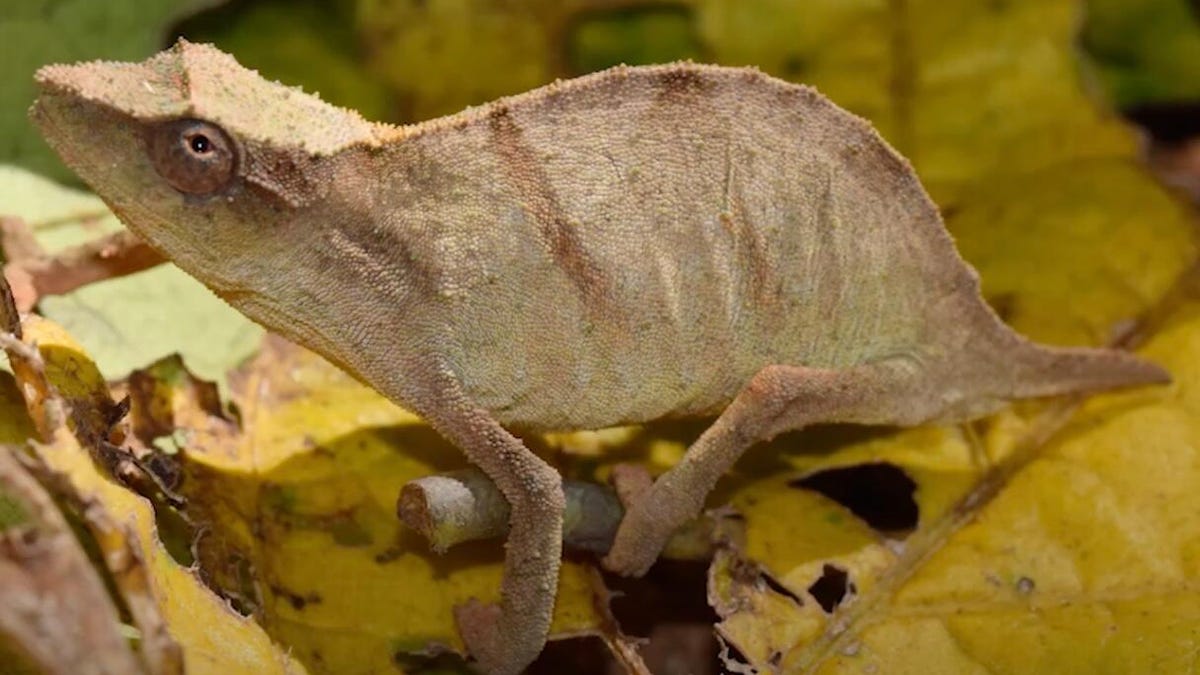Scientists discover tiny chameleon once feared extinct, but its future is uncertain
"When we found it we got goosebumps and just started jumping around."

Scientists were thrilled to find living Chapman's pygmy chameleons, but disappointed to discover their populations are isolated and can no longer reach each other to breed.
One of the world's rarest and smallest chameleons, a creature feared extinct, has been found clinging to life in the rainforests of Africa. Now scientists are calling for an urgent conservation effort to save the critically endangered species before it's too late.
Chapman's pygmy chameleon, which grows to be just 2 inches (5.5 centimeters) long, was first described in 1992, but went years without being spotted again. Much of its native habitat, the forest in the Malawi Hills, has been cut down for crop growth, and conservationists have worried the species might not have survived the deforestation.
A team from the South African National Biodiversity Institute and the Museums of Malawi surveyed remaining forest patches in hopes they might find some still alive. Walking trails at night using torchlight, they spotted their first pygmy chameleon at the forest's edge, and erupted in gleeful surprise.
"When we found it we got goosebumps and just started jumping around," professor Krystal Tolley of the South African National Biodiversity Institute and the University of the Witwatersrand said in a statement. "We didn't know if we would get any more, but once we got into the forest there were plenty, although I don't know how long that will last."
The team conducted their field expedition in 2016, but published their findings Monday in Oryx -- The International Journal of Conservation. The study details how the team compared current satellite images of the Malawi Hills with images taken in the 1980s to assess the sweeping extent of habitat loss, then turned to crowdfunding platform RocketHub to raise money for their surveying efforts. They raised $5,670 (roughly £4,150, AU$7,824), enough to scour two high-elevation forest patches for the creatures, which live on the forest floor and blend in with dead leaves for camouflage.
Chameleons are among the most threatened reptiles in the world, with at least one-third of all species threatened with extinction, says Christopher V. Anderson, an assistant professor of biology at the University of South Dakota and chair of the International Union for Conservation of Nature's Chameleon Specialist Group, a network of volunteers who support the conservation of wild chameleons and their habitats. In the forests of mainland Africa, there are five critically endangered chameleon species in the forests of mainland Africa, according to the study, and all are threatened by forest loss.
The pygmy chameleon has its ardent fans. "They are little, gentle creatures," Tolley said. "Other chameleon species can be hysterical, hissing and biting, but pygmy chameleonsare gentle and just beautiful."
But the future of the reptile, which is listed on the International Union for Conservation of Nature's Red List of Endangered Species, is uncertain.
The survey team recorded the location of each chameleon, took tiny tissue samples from the tails of males for genetic analysis and then returned the reptiles to the perches where they were found. DNA analysis suggests they're trapped in their forest patches, cut off from one other and unable to move between bits of forest to breed.
"The forest loss requires immediate attention before this species reaches a point from which it cannot return," said Tolley, who recommends making the remaining forest part of the nearby Matandwe Forest Reserve so it can be proclaimed a Key Biodiversity Area, and then introducing strong measures to ensure its protection.
"Urgent conservation action is needed, including halting of forest destruction and recovery of habitat to promote connectivity," Tolley added, with Anderson noting that a draft action plan for the species is in development.
Some might wonder why they should care about the endangerment of one chameleon or another. But the loss of one species can affect an entire ecosystem.
"While it may seem unimportant if we lose one salamander or rat species, it matters because all species are connected through their interactions in a web of life," explains Columbia University Climate School. "A balanced and biodiverse ecosystem is one in which each species plays an important role and relies on the services provided by other species to survive."

